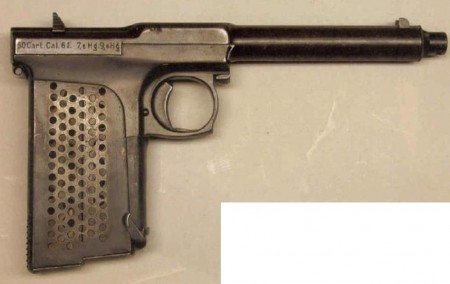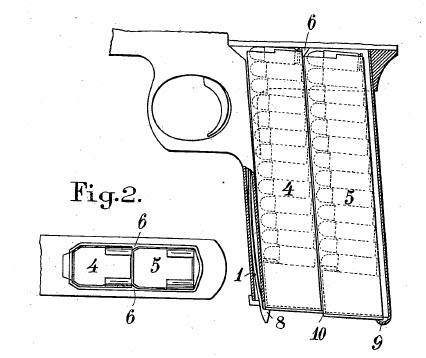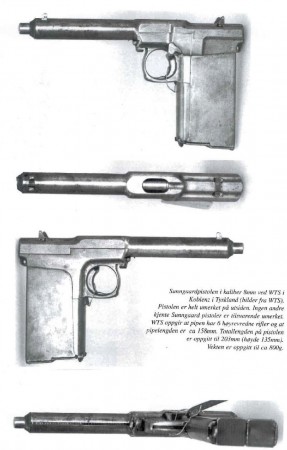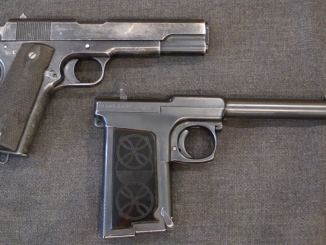Harald Sunngård was Norwegian inventor in the early years of the 20th century who noticed a common perceived weakness of automatic pistols: reloads under stress were often bungled by shooters, leaving them vulnerable to return fire without being able to shoot back. Doing the classic inventor thing, Sunngård figured out a solution to the problem – a two-part solution, in fact. The first part of his solution was to use a big magazine and a small cartridge, to maximize magazine capacity. The second part of his solution was to store a spare magazine right in the magazine well of the pistol for immediate use.

The grip of the pistol is long enough front-to-back to store two identical magazines. The front magazine sits higher than the rear one, and the boltface on the slide feeds rounds from the front magazine into the chamber. Once the front magazine is empty, the shooter ejects it, and need only slide the rear magazine into the front position (and rack the slide) to continue shooting. There is a misconception that the pistol will fire automatically from both magazines in succession, but this is not true.
In addition to having the handy spare available, Sunngard designed the magazines to hold no fewer than 25 cartridges each (in the more common 6.5mm chambering). This gave the pistol a total of 50 rounds stored on-board, which was a major point in Sunngard’s marketing.
The 6.5mm cartridge designed for the pistol had a 23mm overall length, and used a 19mm case. The projectile was a scant 28.5 grains (1.85 gram), and Sunngard claimed a muzzle velocity of just under 2000 ft/s (600 m/s) – which is almost certainly an exaggeration. There was also an 8mm version of the pistol made in much smaller numbers, which fired an equally light projectile (29gr / 1.88g), and may have gotten closer to the claimed velocity (magazines for the 8mm version held 18 rounds each).


The process for moving the spare magazine into position is fairly well described in the patent (attached below). The main magazine catch is basically a heel release on the front edge of the magazine well, and it is pushed back in the typical manner to allow the primary magazine to be removed. Then the rear magazine is pulled slightly forward and down as if to remove it from the gun. The rear magazine is then slid forward into the front position and pushed back up to lock into place on the magazine catch. A pair of small guides (labelled “6” in the patent drawing above) at the top of the magazine well prevent the magazine from being pushed backwards into the now-empty space for the spare magazine, and these guides are the reason the spare mag must be pulled down and then pushed back up. When initially loading the pistol, the spare magazine is inserted first, and locked back into its compartment (held up by a fixed shelf, “9”). Then the primary magazine is inserted just like in any other pistol.
Sunngard apparently tried hard to market the pistol to a variety of military forces, but found no takers. He was able to get the gun entered into the 1914 Norwegian military trials, where it was bested by the Colt 1911 (we don’t have a testing report from the trials, which would be very interesting to read). If I had to guess based on the general attitudes of the day, I would suspect that Ordnance officers found the reloading process awkward, the cartridge underpowered, and the need for a very high capacity pistol unconvincing.
Mechanically, the Sunngard is pretty simple. It uses a plain blowback action, as no locking system is necessary for its small cartridge. The barrel is fixed to the receiver, and a recoil spring is located around the barrel and inside the barrel shroud/slide.
Technical Specs
Caliber: 6.5mm (also 8mm)
Cartridge: 6.5mm Sunngard (6.5x19mm) (also 8x19mm)
Bullet weight: 28.5 gr (1.85g)
Overall length: 8.0in (203mm)
Barrel length: 6.2in (158mm)
Height: 5.3in (135mm)
Weight unloaded: 26.8oz (760g) (28oz/800g for the 8mm variant)
Weight loaded: 33.8oz (960g)
Patents
US Patent 972,087 (Harald Sunngard, “Automatic Firearm”, October 4, 1910)



Hi,
Having 50 rounds ‘onboard’ in a pre-WWI pistol is mind blowing. Especially when having even 1- 4 more rounds in a weapon was considered a significant advantage over the revolver’s 5 or 6 at that time.
Damn shame it used such a whimpy cartridge because it could have had an interesting career if someone had adopted it.
Any idea how many were manufactured?
Or what one in reasonable condition would be worth?
Thanks
Ian
I wasn’t able to find any production numbers, but I doubt it was more than a handful. The price today would be high, I’m sure, but probably less than experimental German or American pistols.
The diminutive cartridge is clearly a major part of WHY it was able to hold 25 rounds per mag, though.
Here’s info on the 6.5×19, sorry it’s in Spanish.
http://www.municion.org/6Mm/6_5SunngardSR.htm
With a 28 to 29 grain slug at 2000 FPS (assuming it actually got up that high, which I also question) the pistol would have had an ME in the 250-270 FPE range, or slightly greater than a typical .38 Special load. Of course, with this many rounds on tap, you could probably afford to dump three or four into an assailant to convince him to cease doing so. You’d still have enough for any friends he might have brought along.
The slide (?) inscription is puzzling to me (probably because I don’t read Bokmål or speak Nynorsk). The “50 Cart. 6 (small)5” is obvious; “50 cartridges 6.5 (mm)”. But what does “7, eHg. 9, 6(?)Hg.” mean?
cheers
eon
The inscription is in English (although it also works in French). If it was in any other Germanic language,including Norwegian, it would have said “50 Patr.”(Patron)
Strange to see hectogrammes used for technical information. It seems to have fallen from favour in later years.
Yes, the deca- and hecto- multiples are rarely used for anything anymore, since in most cases they are not very useful. Instead of 1 hg (the official prefix for hecto in SI is h, not H) one can almost as easily write 0.1 kg.
Hectogrammes are still commonly used in Scandinavia. The same goes for decilitre.
Judge: Why did you put fifty bullets into these men if you were only defending yourself?
Owner of Sunngard pistol: That’s all I had, your honor, and the rounds are pretty weak. I didn’t stop shooting until they all stopped moving.
Well, this scenario would be true if the muggers had used tight rope bindings to prevent themselves from bleeding to death quickly if shot in places other than the head or important blood vessels…
Those are loaded and unloaded weight of the gun, in hectograms (1hg = 10g). Why they chose to engrave that on the gun, though, I have no idea.
The darn thing doesn’t even weigh a quarter of a pound fully loaded.
Theres a slight error or typo, hectogram = 100g so the loaded weights is 2.12 pounds not .212
Thank you, all. And no, I have no idea why they’d do that, either.
cheers
eon
IIRC, the chart lists 760 grams as the EEW and 960 grams as the loaded weight. 760= 1.68 pounds, or 26.8 Oz empty and 7.05 Oz more loaded?
No, it weighs 1.67 pounds, or 27 Oz. empty and 7 Oz more loaded. Then there is the MV issue. Loads from a disk tells me it could easily exceeded 2,100 FPS with out exceeding, or even matching 9 Para pressure levels in either caliber and the 8 mm cartridge was probably loaded with a heavier projectile than that stated. I think it is a typo as a 1.88 gram 8 mm bullet would be too short to stabilize WO risk of tumbling in the BBL. A certain length of parallel sided body is required to keep the bullet point first, generally regarded as about 0.6 calibers long. That slug would Mass about 2.9 grams at a density of 10.3 Gm/Cm^3. Finally, With the recent two decades worth od success with micro caliber self defense ammo, this seems like a great idea, but with lousy execution?
Well, it’s a handy way to make sure the testers know these things even if someone bungles up the paperwork.
Love the early semiauto frankensteins.
Agreed. That is a very interesting–if also bizarre-frankenpistol! Cool post! Thanks!
From the Burgess Shale era of the Autopistol…
Eventually un-common sense prevailed, and set the standard for what we now see as “normality”.
Fortunately for pistol designers, it is still possible to play with such ideas again – unlike the wierd and wonderful critters of the Cambrian Period, and thanks to people like Ian, their DNA has not been lost for all time.
Oh gawd,… me too.
My favorite era of handguns,
from the elegant to the oddball,
tactical to impractical,
the Baby Hammerless to the Mars,
there was a bit of everything for every interest.
So this is the pistol Hollywood uses in most movies!
Impressive. 50 rounds in a time when 6 or 8 was normal(revolver/Luger). Even if they don’t have much power, 25 would be a massive step up, but he went ahead and added another mag. 50 rounds in your pocket is a lot of shooting.
Imagine if it had a fire-selector switch.
In the high-firepower department, the French M. Seytres (St. Etienne)-made Pistolet Automatique’ Union 7.65mm Browning pistol, basically an Eibar type, was normally supplied with a standard 7-shot magazine, but could also be had with a 35-round magazine looking rather like a big letter “J”. I can’t find a picture of the monster online, but it’s on p.465 of Handguns of the World by Ezell.
Either one would definitely give an opponent pause, I’d suspect. Granted neither one is “major caliber”, but nobody in their right mind would want to be shot even once with either of them, let alone 20 or 30 times.
cheers
eon
9 para also has a 19 mm case, would the need for locking this heavier cartridge make a 9 para Sunngard impossible?
It would definitely need a locking breech to be adapted to 9mm Para. Keep in mind that the slide weight and recoil spring were set up for a 29-grain bullet, not the 115-147 grain bullet used in 9mm Para.
Interesting and kind of impressive design, but not very ergonomical with that grip angle.
Wonder how reliable it was.
He might have had a chance if he’d teamed up with a good cartridge designer. Getting half decent power out of a cartrdge with that short an overall length must have been a real challenge in 1910.
On municion:
http://www.municion.org/6Mm/6_5SunngardSR.htm
you can see Sunngard with safety lever on left side.
I cannot translate, but at the top of the MUNICON link here, I see it mentions 6.35 Browning.
Was there a variant made for the .25 ACP as well?
…Sure, .25 ACP is a pea-shooter, but I’d love to have a high capacity pistol that would eat it nonetheless!!!
Not much market for a high capacity .25 ACP pistols. There have been some fairly high capacity .32 ACP pistols such as the CZ 83 (15 rounds), but they have not been a big commercial success. The CZ 83 was discontinued in 2012 without replacement. Americans usually prefer bigger calibers, even if it means much smaller capacity, and there is not much demand for compact carry guns outside the US.
In Europe gun designer if use .25 ACP want pistol as small as possible, for example Walther Model 9 is only 99mm (less than 4″) in overall length. However I know one European firearm chambered in .25 ACP and being high-capacity: the HDH revolver:
http://en.wikipedia.org/wiki/Henrion,_Dassy_%26_Heuschen_double-barrel_revolvers
Version chambered in .25 ACP hold 20 rounds.
Yes, the .25 ACP pistols available today are almost exclusively small pocket pistols like the Baby Browning and the Beretta Bobcat. Such pistols were of course the reason for the introduction of the .25 ACP cartridge from the start, so it’s hardly surprising.
I don’t know who would actually buy a high capacity .25 ACP pistol outside the small circle of gun enthusiasts who would want it for the curiosity value. For plinking and target shooting .22lr is a much better choice. For self defense .32 ACP is a much more potent cartridge while still having a pretty mild recoil. I can see high capacity .32 ACP pistols as a technically (but not necessarily commercially) viable, more controllable alternative for compact low capacity .380 ACP or 9x19mm pistols, but .25 ACP is simply too weak for that.
I don’t believe you understood why a high capacity .25 would be interesting to me. It is NOT because I believe there is a practical application or a market for such a toy, but rather that I enjoy collecting anachronisms, – things that exist for no practical reason.
Actually I did understand that it interests you as a curiosity, but I was merely pointing out that there is virtually no market for such a thing, and therefore mass-production will likely not happen in the foreseeable future.
If I understand correctly the 6.5 Sunngard use the .25 Auto case (i.e. 6.5 Sunngard is wildcat from .25 Auto). What is interesting only the British made cartridge – headstamp ELEY ·6.35· – is shown on Municion.
It’d be nice if there were an English-language mirror of municion.org, since Google Translate and the like don’t exactly give ideal results.
First, that might have worked out without the spare mag.
Second, the .25 is no elephant gun, but we forget often that it gives you .22 rifle power out of a tiny pistol.
Third, there are high capacity .25s, or at least one: the Lercker machine pistol.
As far as muzzle energy goes, .25 ACP from a 2″ barrel is roughly equivalent to .22lr from a 4″ barrel, of course depending on the load, but in that ballpark. The main advantage of the .25 ACP over the .22lr is that it’s a centerfire cartridge, so with reasonable quality ammunition you have a very good chance of emptying the 6 or 7 round magazine of your pocket pistol without malfunctions.
The fear of misfires of rim-fire arise in times when chemistry was at lower level and quality control was less strict. Now .22 rimfire are more reliable than in the early 20 century. However .25 ACP has advantage over .22LR in pocket pistol: the .25 ACP is optimized for short barrel and .22 Long Rifle is optimized for Rifle-long barrels, hence when .22LR is fired in pocket firearm it is no enough time to burn for powder and energy of unburned powder is lost.
You are of course quite right about increased reliability of rimfire cartridges and the fact that .22lr is optimized for longer barrels than 2″, but the final conclusion is still largely the same: the .25 ACP has a small advantage in muzzle energy and also a small advantage in reliability. When you combine these advantages, .25 ACP definitely makes more sense than .22lr as a self-defense cartridge fired from pocket pistols. From a 2″ to 3″ barrel it does not, however, equal .22lr fired from a long barrel pistol, let alone from a rifle.
There was an Mp40 variant with a side by side “racked” configuration apparently i.e. When one was empty you would push the other into position presumably, without having to withdraw it.
That system would not be particularly practical in a pistol probably, due to ergonomics etc.
The Smith&Wesson 1940 rifle, did that have a similar action to this gun “minus the magazine” out of interest?
https://www.forgottenweapons.com/dual-magazine-mp40i/ 🙂
The S&W1940 looked similar, but was mechanically entirely ordinary. The rear half of the magazine well was nothing more than a tube to direct empty casings down out of the gun.
The lack of military interest may have been in part due to the idea that it held too much ammo, and would encourage soldiers to waste it. I can recall reading of this mentality several times, and that the notion actually influenced the feeding system and cartridge capacity of 30-40 Krag.
A Old breed of “DOUBLE-STACK”
I have number 14 – it was expensive
What is the purpose of the apparent leaf type spring visible inside the bottom of the trigger guard just forward of the trigger?